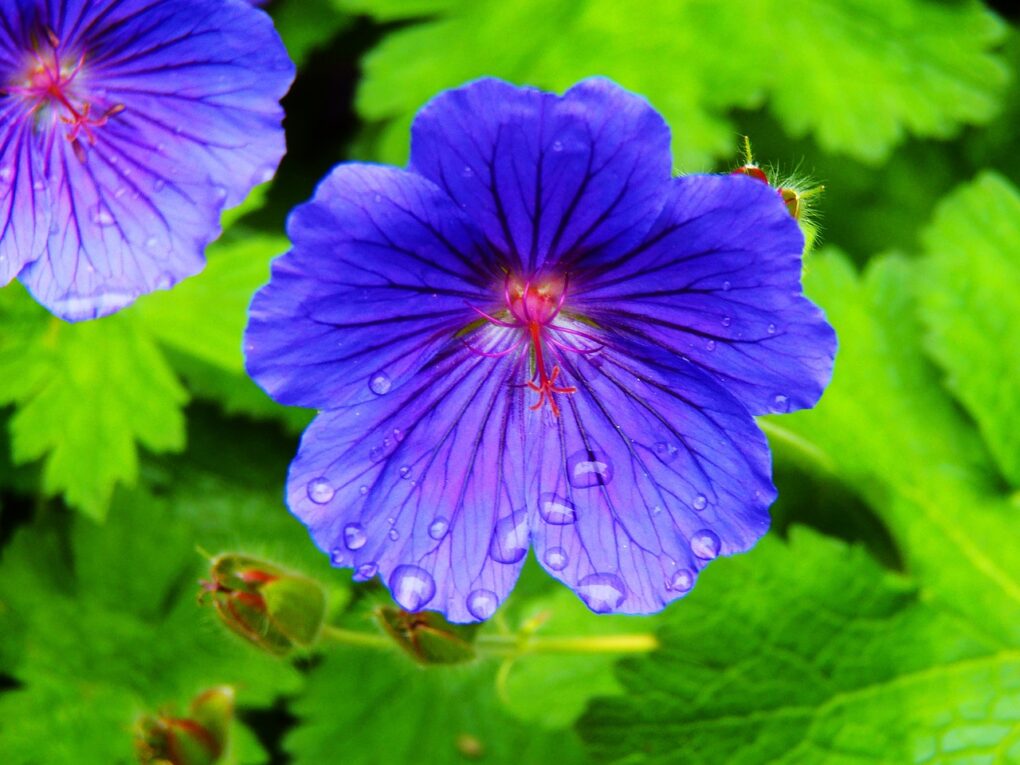Hardy Geranium, also known as Cranesbill Geranium, are a group of perennial plants in the genus Geranium (they are not the same as the annual Geraniums in the genus Pelargonium). Cranesbill Geraniums are indigenous to the Northeastern United States, where they have been utilized as a natural remedy for centuries. The plant features small flowers in a variety of colors.
Active Ingredients of Hardy Geranium
Geraniums look pretty, but the roots contain a powerful ingredient called tannin. The term “tannin” is often used generically to refer to a class of polyphenolic compounds with astringent properties found in various plant tissues. However, the specific types and structures of tannins can vary widely among different plant species.
Geraniums (Pelargonium species) are known for containing a group of compounds called geraniins, which are a type of hydrolyzable tannin. Hydrolyzable tannins consist of polyphenolic structures esterified with sugar molecules. Geraniins have been identified in the roots and other parts of some geranium species.
Characteristics of Geraniins (Hydrolyzable Tannins)
Structure: Geraniins have a complex structure consisting of polyphenolic units linked to sugar molecules, such as glucose or rhamnose.
Hydrolysis: These tannins can be hydrolyzed by enzymes or acids, releasing the polyphenolic components, such as ellagic acid and gallic acid, along with sugars.
Astringency: Hydrolyzable tannins contribute to the astringency often associated with certain plant tissues.
Health Benefits of Hardy Geranium
Many people feature the flowers in their gardens without realizing the potential healing powers that the plants possess.
Tannin is responsible for soothing the digestive tract, and it is useful in preventing and treating frequent diarrhoea. Geranium has been used for centuries as a way to treat such problems. The raw plant was used in the past but it is available today in easy-to-use supplements.
Geranium best benefits those with mild gastrointestinal ailments. The presence of tannin in the herb may help alleviate diarrhoea, inflammation in the bladder and other symptoms related to Crohn’s disease.
Historically, geranium was also used in folk medicine to stop abnormal bleeding, including that related to menstruation and uterine problems. Tannins can also act as a natural astringent to reduce inflammation and redness related to skin conditions, such as sores. Geranium may be applied topically to help treat haemorrhoids.
Less common uses of the herb are for the treatment of eye conditions, such as conjunctivitis and moderate retina irritations. Diabetic patients may turn to geranium as a possible natural treatment for vision problems.
How to Use Geranium Medicinally
Like many herbs, the healing power of Geranium is derived from the roots. Capsules are the most common forms of the herb today, and they are best taken once or twice a day with a glass of water.
Experienced herb users might opt for a tea version, which is brewed with hot water and consumed throughout the day. Tincture versions of geranium can be more powerful than tea and capsules, so it is important to take extra care. Generally, users take ½ a teaspoon at a time, twice a day.
Shopping
| Visit the new SHOPPING page for a wide selection of great products! |
Always take care when taking herbs and Read Our Disclaimer.
Geranium Herb Notes / Side Effects
Geranium offers a wealth of health benefits, but it is best to use any herb under the strict guidance of a medical doctor or an alternative medicine practitioner. Indigestion is the most common side effect of this plant, and it is usually related to the over consumption of tannin contained in the herb. Generally, it is best not to take Geranium for more than three weeks at a time, unless otherwise directed by a health professional.
Pregnant women shouldn’t use Geranium. Also, you should refrain from using Geranium whilst breastfeeding because the active ingredients can be passed to your infant through milk. Tannins in Geranium may also dry up breast milk altogether.
It is also important to exercise caution when mixing herbal remedies with prescription medications. Geranium contains other active ingredients that can potentially interact with other herbs that have the same features. The ingredients include calcium oxalate, gallic acid and potassium. Take care in combining herbal treatments to reduce the possibility of interactions. Herbs are powerful, and they have the propensity to interfere with or decrease the efficacy of any medications you might be taking.



Leave a Reply